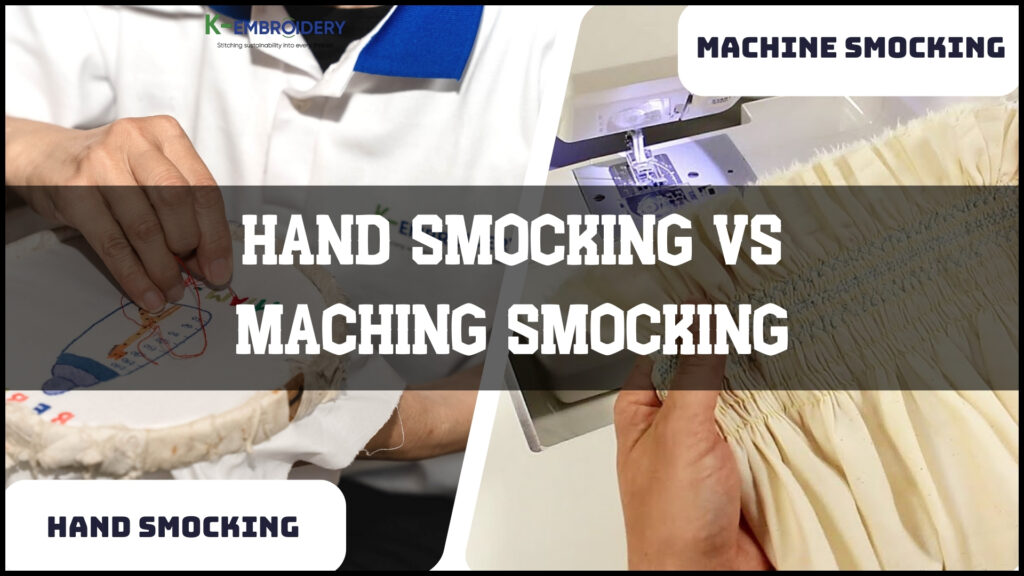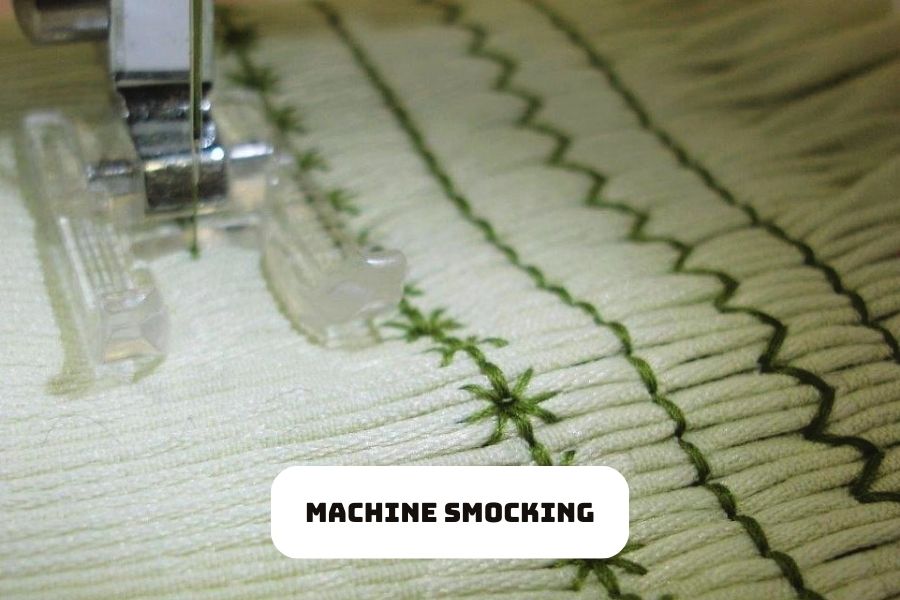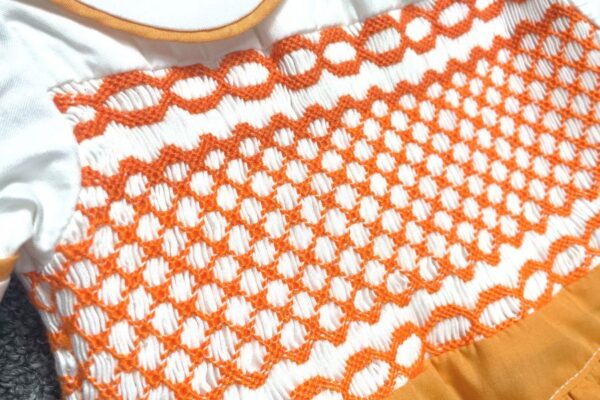Hand vs Machine Smocked: What is the difference Between? Pros, Cons & Techniques
Smocking originated in England and was initially used in the 15th century as a practical method for making garments more flexible. And smocking was used most extensively in the 18th and 19th centuries. The smocking machine was born to assist people and make the embroidery process faster and easier. However, many people still prefer handmade products, why?
Recognizing the differences between hand smocking vs machine smocking is essential for making informed decisions about which technique to use for specific projects. Each method has its own pros and cons, and knowing these differences empowers individuals to choose the most suitable approach based on their preferences, skills, and project requirements.
I’ve been around embroidery my whole life, growing up in a traditional Vietnamese embroidery village. Over the years, I’ve been working with top embroidery suppliers in the US, UK, Nigeria, and China. With all that experience, I can confidently tell the differences between hand smocking vs machine smocking technique. Hand smocked vs machine smocked – Overview here is an overview of the differences between hand smocking vs machine smocking

1. What is Hand Smocked?
Hand smocking is a traditional way of decorating fabric. It involves gathering and sewing the fabric by hand to make pretty patterns. This technique has appeared for a long time to make clothes and other items look special.
Starting hand smocking might seem a bit overwhelming at first, but it’s actually pretty easy and doesn’t cost much to give it a try. You just need some basic materials, which you can easily find, and learn a few simple things. Even kids can do it, and what you create is something you made with your own hands.
2. What is Machine Smocked?
Contrary to hand smocking, machine smocking is done using a sewing machine. The fabric is fed through the machine, and special stitches are used to create the smocked effect.
Besides the conventional method of machine embroidery, you can also employ a standard smocking machine. This technique resembles hand embroidery done on a machine, sometimes referred to as “drawing” with a smocking machine.
Investing in a smocking machine, entails financial commitment, each costs around $500 up to $4,000. The purchase cost, along with patterns and equipment, signifies your dedication to this craft. Learning machine embroidery involves understanding how your specific machine operates with various materials, although you don’t need to learn stitching techniques unless you’re engaging in free-motion embroidery, which requires some practice.

3. Difference between hand smocked and machine smocked
Comparable differentiating factors include:
| Criteria | Hand Smocked | Machine Smocked |
| Thread Types |
|
|
| Stitching Techniques |
|
|
| Aesthetic Quality | Soft, artistic, unique, and handcrafted appearance. | Uniform, precise, and consistent across products. |
| Speed | Slow; depends on skill and manual labor. | Fast; high production efficiency. |
| Applications | High-end fashion, children’s clothing, products requiring fine craftsmanship. | Industrial production, mass-produced garments. |

4. Pros and Cons of Hand Smocking
Hand Smocking has advantages and disadvantages such as:
4.1. Pros
- Artistry and Customization: Hand smocking lets you be very creative. You can make your own designs and use different colors and textures to make something unique. And this is the major difference between hand smocking vs machine smocking.
- Unique Textures and Designs: Hand smocking makes fabric look special. The stitches are done by hand, so they have a soft and natural look that can’t be copied by machines.
- Portable: You can do many hand-smocking projects wherever you are, like when you’re traveling or during your commute. It’s hard to carry a smocking machine around, but hand smocking is portable.
- Relaxing: Smocking by hand can be calming and peaceful. Just the act of smocking can make you feel relaxed, whether you’re using a machine or doing it by hand.
4.2. Cons
Hand smocking has its drawbacks, primarily due to the time and skill required for the process.
- Time-Consuming: Hand smocking is time-consuming as each stitch must be meticulously done by hand. This meticulousness cannot be rushed, often resulting in projects taking significantly longer to complete compared to using a machine.
- Skill Required: Hand smocking demands a considerable amount of practice and skill. It’s not something that can be mastered overnight, as it requires learning the correct techniques and methods. Initially, it might feel challenging and even daunting, but with consistent practice and dedication, one can improve their smocking skills and create beautiful pieces of work.
5. Pros and Cons of Machine Smocking
Machine Smocking has advantages and disadvantages such as:
5.1. Pros
- Faster and Efficient: Developed countries like the US, UK and Germany have relied on smocking machines in their industries for many years. These machines significantly enhance productivity and accuracy, resulting in faster work with fewer mistakes. A smocking machine can typically produce anywhere from 50 to 200 units per hour, depending on the specific circumstances.
- Consistent Stitches: Machine stitches are always evenly spaced and neat. This makes whatever you’re sewing look really tidy and nice. Unlike sewing by hand, where the stitches might be different sizes or not evenly spaced, machine stitches are always consistent. This consistency not only makes things look good but also makes them stronger and more durable.
- Convenient: Once you become proficient in operating your smocking machine, including tasks like threading the bobbin and using the presser foot, machine smocking becomes highly convenient and efficient for projects of various sizes. The initial setup is the key to unlocking its convenience.
5.2. Cons
- Limited Customization: Machine smocking doesn’t offer as much freedom for unique designs as hand smocking. You can spot machine smocking products with some tell tale signs – the designs are more basic, usually just zig zags or lattice in one or two colors. Also, the stitches tend to be looser and thinner and the pleating more spaced out.
- Restricted Fabric Choices: Some fabrics may not work well with machine smocking, limiting the options for projects. A thick fabric will be too bulky and not appropriate for machine smocking.
6. Techniques and Tips
After telling the differences between hand smocking vs machine smocking, in this section, we’ll explore some handy techniques and useful tips to help you with your business.
Whether you’re just starting out or you’ve been crafting for a while, we’ve got some easy-to-follow advice to make your crafting journey smoother and more enjoyable.
6.1. Hand Smocking Tips
- Select fine needles and thread that match your fabric to ensure smooth stitching.
- Begin with simple patterns and gradually progress to more complex designs as you gain confidence.
- Keep the fabric taut but not too tight while stitching to ensure uniform gathers.
- Iron the smocked fabric gently on the wrong side to set the gathers without flattening them.

6.2. Machine Smocking Tips
- Stiffer/heavier weight fabrics may be too bulky.
- Use some scrap fabric to test the quantity of gathers as well as the decorative stitches.
- Ensure the tension and pressure on your sewing machine are set correctly to prevent fabric puckering or stretching.
- If you have a 2mm wide twin needle, try using it for decorative stitches. You can also use two different colored threads for a unique look. The needle will make stitches that overlap or run parallel depending on the decorative stitch and width.
- Make sure to pick the right needle from the on-screen menu before you start sewing so the machine works correctly.
6.3. Hybrid Techniques
- Use hand smocking for intricate details and machine smocking for larger areas to save time.
- Add beads, sequins, or embroidery to enhance your smocked designs, combining handwork with machine stitching.
- Combine different fabrics or textures in your smocking projects for added visual interest and creativity.
7. Which Do Customers Prefer?
There is a fact that in the middle war of hand smocking vs machine smocking, hand-smocked products are likely to be more valued than machine-smocked ones. Hand-smocked products are more expensive, but in return, they are more sophisticated and exude a timeless elegance that cannot be replicated by machines.
As a 100% hand-smocked embroidery factory, K-Embroidery takes pride in creating unique, meticulously crafted pieces that exude charm and elegance. From intricately children’s smocked dresses to delicately embroidered accessories like napkins, our products showcase the timeless artistry of hand-smocking.
But don’t just take our word for it – hear from our satisfied customers who rave about the quality and attention to detail that define K-Embroidery. View our customers’ feedbacks and reviews here.

8. Conclusion
Hand smocking vs machine smocking each have their own advantages and disadvantages. Hand smocking offers unique, handmade charm and intricate designs but requires more time and skill. Machine smocking, on the other hand, is faster and more consistent but lacks the handmade touch and customization options of hand smocking.
Consider the specific requirements of your business to choose between hand smocking vs machine smocking, such as time constraints, desired level of customization, and available skill level.


